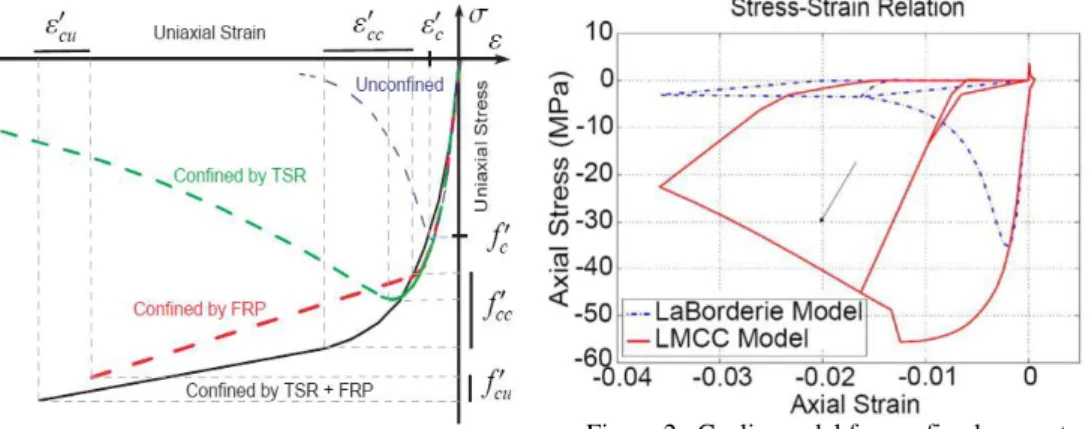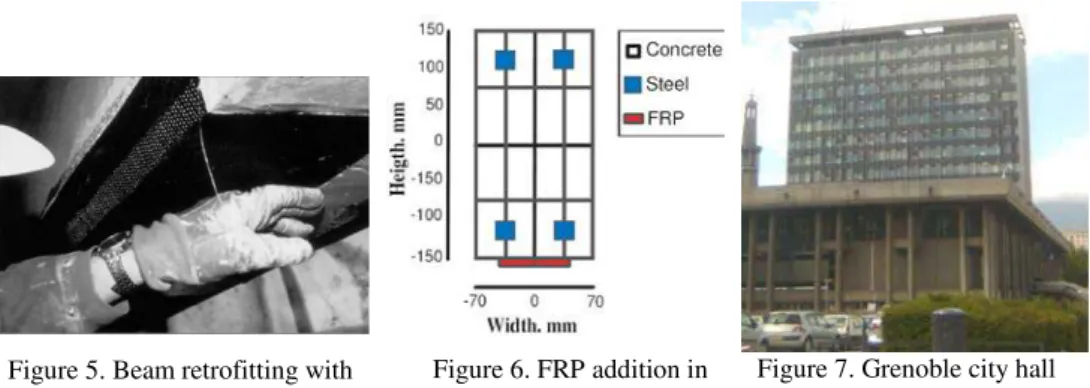HAL Id: hal-01008876
https://hal.archives-ouvertes.fr/hal-01008876
Submitted on 23 Jan 2020
HAL is a multi-disciplinary open access
archive for the deposit and dissemination of
sci-entific research documents, whether they are
pub-lished or not. The documents may come from
teaching and research institutions in France or
abroad, or from public or private research centers.
L’archive ouverte pluridisciplinaire HAL, est
destinée au dépôt et à la diffusion de documents
scientifiques de niveau recherche, publiés ou non,
émanant des établissements d’enseignement et de
recherche français ou étrangers, des laboratoires
publics ou privés.
Distributed under a Creative Commons Attribution| 4.0 International License
Seismic vulnerability reduction: numerical modeling of
frp reinforcement using multifiber beams elements
Cédric Desprez, Saber El Arem, Panagiotis Kotronis, J. Mazars
To cite this version:
Cédric Desprez, Saber El Arem, Panagiotis Kotronis, J. Mazars. Seismic vulnerability reduction:
nu-merical modeling of frp reinforcement using multifiber beams elements. AGS’10, Euro Mediterranean
Symposium On Advances in Geomaterial and Structures, May 2010, Djerba, Tunisia. pp.459-464.
�hal-01008876�
1
SEISMIC VULNERABILITY REDUCTION:
NUMERICAL MODELING OF FRP REINFORCEMENT
USING MULTIFIBER BEAMS ELEMENTS.
Cedric Desprez
1, Saber El Arem
1, Panagiotis Kotronis
2and Jacky Mazars
1.
1
Laboratoire Sols Solides Structures et Risques (3S-R) UJF/INPG/CNRS UMR 5521 Domaine Universitaire BP 53 38041 Grenoble cedex 9, France.
Cedric.Desprez@hmg.inpg.fr, Jacky.Mazars@hmg.inpg.fr 2
Research Institute of Civil Engineering and Mechanics (GeM), UMR CNRS 6183 Ecole Centrale de Nantes, 1 rue de la Noë, BP 92101, 44321 Nantes Cedex 3, France. Panagiotis.Kotronis@ec-nantes.fr
Abstract. This paper presents a simplified modeling strategy for reproducing the behavior of
beam-column structures reinforced with Polymer Reinforced Fibers (FRP). A 1D concrete constitutive model has been recently proposed, suitable for both monotonic and cycling loadings [1]. The model is inspired on two well-known concrete laws, one based on damage mechanics theory (La Borderie concrete damage model) and one based on experimental studies (Eid & Paultre's confined concrete model). Spatial discretization is done using multifiber Timoshenko beam elements. Validation of the strategy is provided using two case studies: a retrofitted bridge pier and a vulnerability analysis on an existing building.
Keywords. FRP, seismic loading, vulnerability, concrete, damage mechanics, retrofitting.
Acknowledgement. The authors gratefully acknowledge the support of the Sherbrooke civil
engineering department and the French ANR ARVISE research project.
1
INTRODUCTION
Nowadays, Reinforced Polymer Fibers (FRP) are often used in retrofitting of civil engineering structures. Their role is mainly to confine existing columns and to increase the bearing capacity of beams or walls through axial reinforcement. This paper deals with a simplified model to simulate the behavior of FRP confined columns and beams or walls. A uniaxial (1D) concrete constitutive model, suitable both for monotonic and cycling loadings, is presented. Two case studies are used for validation: a retrofitted bridge pier and a vulnerability analysis on an existing building.
2
MODELING TOOLS
In order to decrease the number of degrees of freedom and thus to simplify the finite element mesh, Timoshenko multifiber beam elements are often used to discretise RC specimens [2]. This approach is also adopted for the calculations presented in this paper.
2
Shear is considered linear, allowing thus using 1D constitutive laws. Regular concrete is modeled using La Borderie’s model [3]. Based on damage mechanics, it takes into account the opening and closing of cracks. In order to reproduce the behavior of confined concrete under monotonic loading, the predictive model of Eid & Paultre [4] is adopted. It is a global model taking into account internal (due to Transverse Shear Reinforcement TSR) and external (due to FRP) confinement (Figure 1). The cyclic behavior of steel is simulated using the classical Menegotto-Pinto model.
3
SIMULATING RC COLUMNS CONFINED WITH FRP
3.1 RC columns confined with FRP: principle of modeling
In concrete columns, the main mechanical effect of the internal and external confinement is to reduce the development of lateral expansions that cause the most part of the damage. A simplified way to take this effect into account using a 1D damage mechanics law is to adapt the damage evolution law due to compression. The proposed strategy consists in adapting the damage evolution of the La Borderie model to fit the evolution proposed in Eid & Paultre's model [1].
Figure 1 . Monotonic model for confined concrete available for different confinement ratio (Eid & Paultre)
Figure 2 . Cyclic model for confined concrete (LMCC model)
3.2 Case study: Bridge pier under axial and flexural load.
Experimental setting
A RC mockup, representative of an existing bridge (1/3 scale) with partial retrofitting, has been recently cyclic tested at the University of Sherbrooke. The bridge pier contains 3 identical columns of 2.1m height and a transverse beam (Figure 3). Only the two outer columns are retrofitted with FRP (the central column and the beam are not retrofitted). The axial load on each column varies from 10% to 20% of its estimated capacity in uniaxial compression during the cycles. The lateral imposed displacement is cyclic with increasing intensity. During the test, the force-displacement curve is measured (Figure 4).
3
Figure 3. Bridge pier mockup with partial retrofitting.
Figure 4. Numerical result Vs experimental data.
Numerical modeling
Each column is modeled using Timoshenko multifiber beam elements. They are considered fixed at the bottom. The transverse beam is assumed elastic with a reduced section to take into account the initial cracks in concrete. Each multifiber section contains 24 concrete fibers and 15 fibers representing the longitudinal steel bars. Material parameters are based on experimental tests [5]. The material model used for the unconfined concrete (central column) is the La Borderie model; for the confined concrete (outer columns) the LMCC model and for the steel bars the Menegotto-Pinto model. In Figure 4, numerical results show relatively good agreement with the experimental data in terms of maximum values but also hysteretic cycles.
4
SEISMIC VULNERABILITY ANALYSIS OF AN EXISTING RC
BUILDING:
SIMULATING RC ELEMENTS AXIALLY
RETROFFITED BY FRP
4.1 Axial reinforcement with FRP: principle of modeling
FRP reinforcement, bonded on one side of a RC element (beam, wall…), has a function similar to the one of an external reinforcement bar (Figure 5). Using multifiber beams, one can easily numerically reproduce this contribution by adding a specific fiber in the multifiber beam section (Figure 6). The role of FRP is then simulated adopting a linear elastic brittle material law. Concrete and steel are again modeled again using La Borderie and Menegotto-Pinto models respectively.
4
Figure 5. Beam retrofitting with FRP bonding on lower side.
Figure 6. FRP addition in multifiber beam section
Figure 7. Grenoble city hall
4.2 Case study: RC building
The proposed method is used to simulate the nonlinear behavior of an existing structure (Figure 7) before and after retrofitting. This building is a reinforced concrete structure constructed in1966. Only the tall tower (witch is separated from the rest of the building) is considered (Figure 8). The dimensions are, 43m long, 13m large, and 50m height. The structure is composed of four very stiff rectangular elements (containing the stairs and elevators), slabs, beams and columns.
The building has been modelled using nonlinear multifiber beams for the vertical elements and linear shell elements for the horizontal slabs. The linear dynamic behavior of the model has been validated by in-situ ambient vibration records [6].
Figure 8. Model (no retrofitting): Damage due to traction (D1) in concrete.
Figure 9. Model (no retrofitting): Maximum drift ratio (a) steel strain (b).
5 4.2.1 Vulnerability analysis (without retrofitting)
The first part of the study concerns the analysis of the seismic vulnerability of the structure before applying the FRP retrofitting. A synthetic three-directional signal based on EC8 design code is used for the dynamic nonlinear simulations. Figure 8 presents the results of the numerical analysis in terms of damage, drift ratio and steel strain. More specifically: The behavior of the structure is found mainly flexural without significant torsional effects. This beam-type behavior allows a flexural reinforcement using FRP. Damage due to traction is concentrated on four large areas but no damage due to compression appears. The steel stress-strain evolution shows that plastic hinges are developed in the building.
4.2.2 Vulnerability analysis (with retrofitting)
The second part of the study considers the structure this time (numerically) retrofitted. More specifically, FRP is applied at the four principal piers. The design of the FRP sheets is chosen such as to avoid the plastic behavior of steel bars. According to the results of the previous calculation (Figure 9), FRP is added on the first floor, at the base of the structure and on the five first floors of the upper part. After retrofitting, a classical nonlinear static analysis (pushover) shows that the flexural capacity increases (Figure 10). Indeed, FRP sheets allow reducing the strain localization due to plastic behaviour of reinforced steel bars. However, modifications on the structural dynamic response are surprisingly. FRP allows decreasing the steel strains but new localization patterns appears (e.g. above the last reinforced floor), Figure 11. Moreover, displacements and drift ratio values are slightly modified. One can clearly see the necessity of having numerical tools, as the one presented in this paper, in order to be able to proceed to nonlinear vulnerability studies.
Figure 10. Pushover in the transverse direction: bearing capacity before and after retrofitting.
Figure 11. Model (with retrofitting): Maximum drift ratio (a) steel strain (b).
6
5
CONCLUSION
In this work, a simplified modeling strategy is presented in order to reproduce the nonlinear cyclic behavior of FRP RC structures. More specifically:
• Multifiber beam elements are used for the spatial discretization.
• A modification of the evolution law for the damage variable of the La Borderie model is adopted [1]. The new evolution is based of the Eid & Paultre concrete model. Validation is provided using the experimental results of a retrofitted bridge.
• Extra fibers are added on the multifiber beam element discretization to reproduce the FRP axial reinforcement. A vulnerability analysis on an existing building is performed to validate the approach.
The modeling strategy developed in this paper can serve as a simplified tool to do comparative studies on the vulnerability of RC structures before and after FRP retrofitting.
Bibliographie
[1]. Desprez, C, et al. 2009. Retrofitting reinforced concrete structures with FRP: Numerical
simulation using multifiber beam elements. Rhodes, Greece : Proceedings of COMPDYN, ECCOMAS Thematic Conference on Computational Methods in Structural Dynamics and Earthquake Engineering.
[2]. Mazars, J, et al. 2006. Using multifiber beams to account for shear and torsion : Applications
to concrete structural elements. 52, , Computer Methods in Applied Mechanics and Engineering, Vol. 195, pp. 7264-7281.
[3]. La Borderie, C. 1991. Phénomènes unilatéraux dans un matériau endommageable: Modélisation et application à l'analyse des structures en béton. Thèse de doctorat. Université Paris VI, Paris, France.
[4]. Eid, R et Paultre, P. 2008 Analytical model for FRP-confined circular reinforced concrete
columns. 2008, Journal of Composites for Construction, Vol. 12, pp. 541-552.
[5]. Roy, N. 2006 Réhabilitation parasismique performantielle des ponts avec des polymères
renforcés de fibres de carbone; Thèse de doctorat. Université de Sherbrooke, Canada (Quebec).
[6]. Michel, C, et al. 2009. Full-scale dynamic response of an RC building under weak seismic
motions using earthquake recordings, ambient vibrations and modeling, Earthquake Engineering & Structural Dynamics, http://dx.doi.org/10.1002/eqe.948 (Early View).



